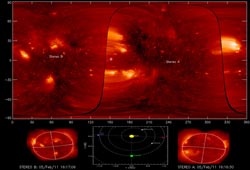NRL Researchers View the Sun in 3-D

Cartesian projection of the entire solar atmosphere as observed by NRL\'s SECCHI EUV telescopes at a temperature of 1.6 million degrees. The lower panels show the individual images from each telescope and the middle panel shows the geometric configuration of the STEREO spacecraft at the time the images were taken. SECCHI acquires such full maps of the sun every 10 to 20 minutes.<br>
A key component of the STEREO mission is NRL's Sun Earth Connection Coronal and Heliospheric Investigation (SECCHI), a suite of five scientific telescopes that observe the solar corona and inner heliosphere from the surface of the Sun to the orbit of Earth.
These unique observations are made in “stereo” by the two nearly identical solar-powered STEREO observatories with one observatory ahead of Earth in its orbit and the other trailing behind. The two observatories trace the flow of energy and matter from the Sun to Earth. The instruments aboard STEREO reveal the three-dimensional structure of coronal mass ejections, the powerful eruptions of plasma and magnetic energy from the Sun's outer atmosphere, or corona.
SECCHI Project Scientist and NRL researcher, Dr. Angelos Vourlidas, explains the significance of this opportunity for the 360-degree view of the Sun, “for the first time, we can take snapshots of the entire atmosphere of a star. To put it in perspective, before STEREO we were like a person trying to get the pulse of a city by watching through a half-open window – not an easy task. Now, STEREO has thrown wide open the window and we can watch the Sun and its activity in its full three-dimensional glory.” Each STEREO telescope sees half the Sun at a time. By combining the two views, NRL researchers can map of the entire solar atmosphere continuously.
Before the three-dimensional view was available, researchers had to wait until an active region rotated across the visible-from-Earth disk in order to study the properties. The problem of having to wait for the proper views to appear is that the corona is highly variable, filled with regions that come and go in a matter of days and explosions that can alter the corona landscape in a matter of hours.
With this capability of a three-dimensional view of the Sun, Vourlidas sees the potential for advances in the field of heliophysics. “We can solve the puzzles behind the evolution and structure of the solar atmosphere, including its violent eruptions, because we will be able to observe every feature and source of activity at the same time all over the Sun and follow their connections that can extend to large distances around the Sun,” he explains. This opportunity for the STEREO spacecraft to view the Sun in three-dimension will be available for the next eight years.
STEREO is the third mission in NASA's Solar Terrestrial Probes Program. STEREO is sponsored by NASA's Science Mission Directorate, Washington, D.C. The Goddard Science and Exploration Directorate manages the mission, instruments, and science center. The Johns Hopkins University applied Physics Laboratory, Laurel, Md., designed and built the spacecraft and is operating them for NASA during the mission.
Media Contact
More Information:
http://www.nrl.navy.milAll latest news from the category: Physics and Astronomy
This area deals with the fundamental laws and building blocks of nature and how they interact, the properties and the behavior of matter, and research into space and time and their structures.
innovations-report provides in-depth reports and articles on subjects such as astrophysics, laser technologies, nuclear, quantum, particle and solid-state physics, nanotechnologies, planetary research and findings (Mars, Venus) and developments related to the Hubble Telescope.
Newest articles

Combatting disruptive ‘noise’ in quantum communication
In a significant milestone for quantum communication technology, an experiment has demonstrated how networks can be leveraged to combat disruptive ‘noise’ in quantum communications. The international effort led by researchers…

Stretchable quantum dot display
Intrinsically stretchable quantum dot-based light-emitting diodes achieved record-breaking performance. A team of South Korean scientists led by Professor KIM Dae-Hyeong of the Center for Nanoparticle Research within the Institute for…

Internet can achieve quantum speed with light saved as sound
Researchers at the University of Copenhagen’s Niels Bohr Institute have developed a new way to create quantum memory: A small drum can store data sent with light in its sonic…





















